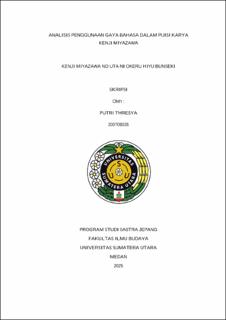| dc.description.abstract | This study aims to describe the forms and uses of figurative language in the poems
Koi to Byounetsu (恋と病熱) and Haru to Shura (春と修羅) by Kenji Miyazawa.
Kenji Miyazawa is one of Japan’s renowned poets, known for his works that center
on themes of life. This study employs a descriptive qualitative method. This method
presents the research narratively through words or sentences explained based on
actual data. The study adopts semantic theory as proposed by Tarigan, semiotic
theory based on Ferdinand de Saussure’s thoughts, and figurative language theory
as referred to by Seto. The data are taken in the form of poems, specifically Koi to
Byounetsu and Haru to Shura by Kenji Miyazawa. The types of figurative language
found in these poems include metaphor, personification, hyperbole, simile,
rhetorical question, and paralepsis. Metaphor is the most frequently used type of
figurative language in Kenji Miyazawa’s poems. The figurative language used in
his works serves various functions, such as enriching meaning, stimulating
imagination, and conveying emotions or messages in a profound way. | en_US |


